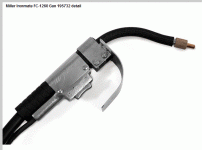You still need the nozzle for self-shielding flux core. The only difference is the gas comes from the wire, rather than a tank. Drop the nozzle and you disturb formation of the shield gas. The wire is more forgiving of gas loss, but it helps to have a nozzle. That said, I've done some "long shot" wire welds using flux-core where the nozzle might as well have been in New Jersey.

Also, you'll probably find that dragging self-shield is going to work better for you, than push. Of course, you also should push up in a vertical weld to get better penetration. Figuring out that conflict is half the fun.
Penetration is always an issue with MIG. It's not the process - it's the person. MIG will create a fluid pool and "look nice" at energies insufficient to properly penetrate and fuse. Stick requires a certain energy just to keep melting, and that will usually be close enough to cause decent penetration. That might be why some people say MIG won't penetrate: it requires a little more attention from the welder to do it right. Also, when you get into the commercial space there is a lot of emphasis on tested procedures in MIG, for that reason.
I second the Hobart wire. It's easy to find and works well. The differences between wires is small, but nuance can count on things like overhead and vertical welding. Might as well get your hand used to running decent wire that you can find anywhere. The Hobart E71T-11 fits that bill. If you shoot between 1/8 and 1/4, suggest you start with a .30 wire. Common and versatile.
Other MIG thoughts...wire size equals melted metal volume and hence proportional to heat input. The more metal you dump, the more heat you transfer to the piece. So thicker wire or faster feed will increase heat. That can be good on thick pieces, or bad for thin sections or those prone to heat stress. Again, all of this is part of the fun.
